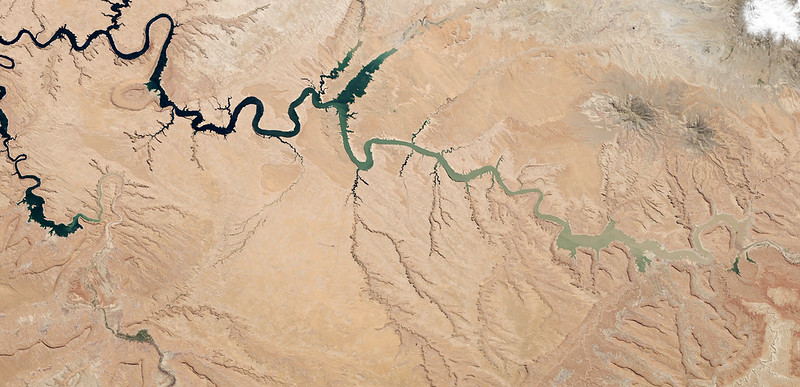
Lake Powell, a major reservoir along the Colorado River, was at less than half its capacity in 2014. A new study, published in Geophysical Research Letters, used tree rings to uncover the most severe drought in 2,000 years of the river's history. Credit: NASA Goddard/Earth Observatory
The ongoing severe drought in the Colorado River Basin has led to the river flowing at 84% of its historic average flow. An even more intense "megadrought" hit the region around 1,800 years ago, a new study reveals. At just 68% of the river's average flow rate, the megadrought is the most severe drought discovered in the arid region yet.
The new study, published in the AGU journal Geophysical Research Letters, used tree-ring data and other climate records to identify a drought period unmatched in severity by the current drought or other ancient droughts. It reveals a greater range of natural hydroclimatic variability in the Colorado River than previously recognized, highlighting a need for water managers to adjust expectations and prepare for even more intense drought.
"Previous studies have been limited to the past 1,200 years, but there are a limited number of paleorecords of moisture variability available back 2,000 years," said Subhrendu Gangopadhyay, lead study author and an engineer at the Bureau of Reclamation. "While there has been research that shows extended dry periods in the southwest back to the eighth century, this reconstruction of Colorado River streamflow extends nearly 800 years further into the past."
The research found that compared to the current 22-year drought in the Colorado River, with only 84% of the instrumental period (1906-2021) average flow at the Lees Ferry gage, the flow during a 22-year period in the second century was much lower, just 68% of this average flow.
"Although tree-ring data are sparse back to the second century, this extreme drought event is also documented in paleoclimatic data from lakes, bogs and caves," said Connie Woodhouse, a professor at the University of Arizona and a study co-author.
"It's quite compelling from the available tree-ring data that the second century experienced an extraordinarily severe drought, highly persistent, and very intense. It's quite remarkable," said Edward Cook, a dendochronologist at Columbia University.
The future of western water
Water managers may use this new extended dataset to understand past droughts better and plan for future droughts.
"The results of this work can provide water managers with an increased understanding of the range of flow variability in the Colorado River," added Gangopadhyay. "It should provide information to help water managers during this drought and plan for even more persistent and severe droughts than previously considered."
"For future work, collection and analysis of more remnant wood can provide further documentation of this second century drought," added Woodhouse.
The ongoing Colorado River Basin drought has extensive impacts throughout the West, including water shortages for homes and crops and decreased generation of hydroelectric power. The new knowledge for how much worse droughts can be, even without anthropogenic climate forcing, points to a potentially grim outlook for water in the West.
"Megadroughts happened naturally in the past, before elevated greenhouse gases. It's kind of scary that the West may have slipped into a new megadrought that might have happened anyway, but is now made worse because of greenhouse gas forcing," said Cook.






